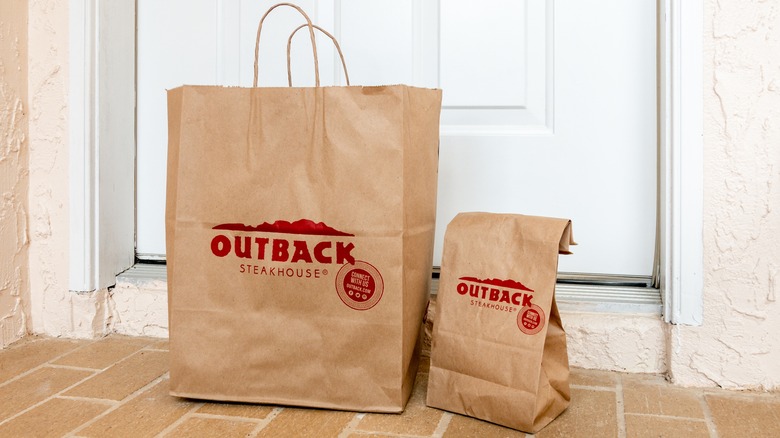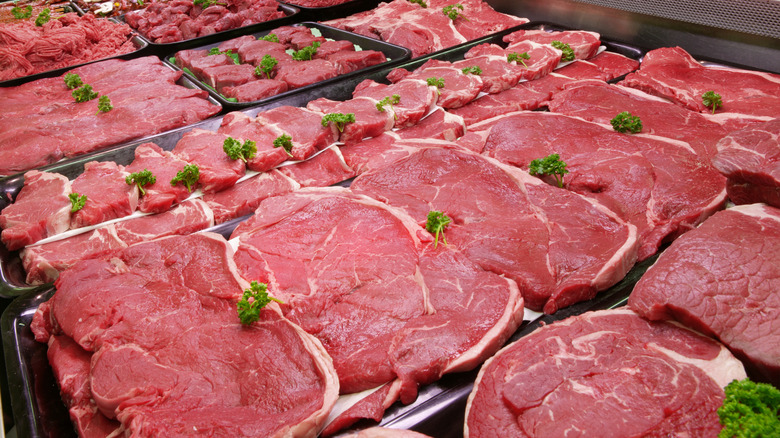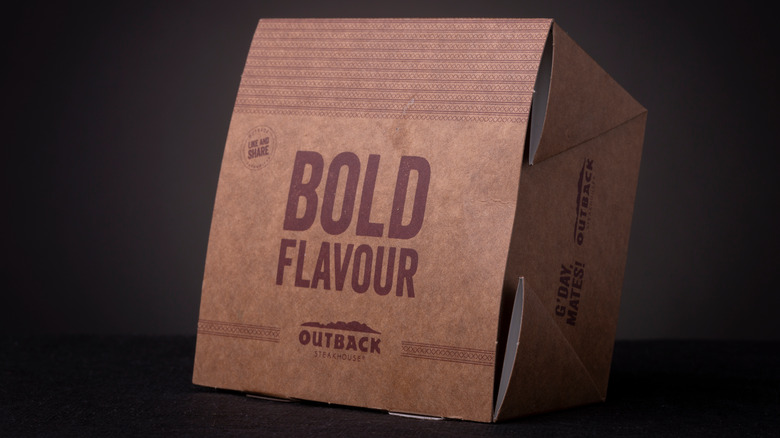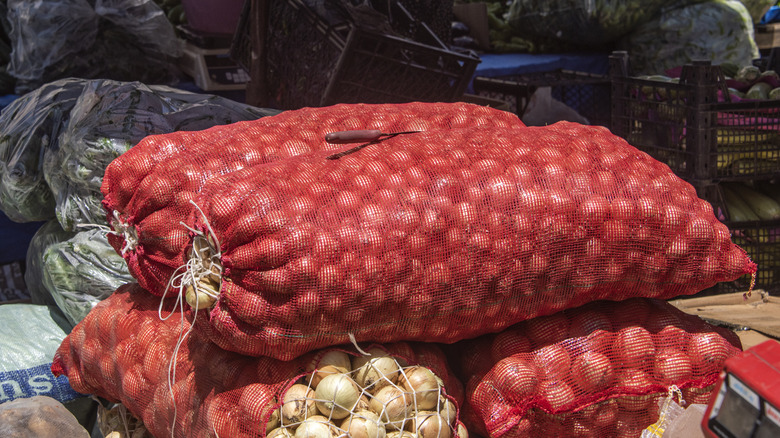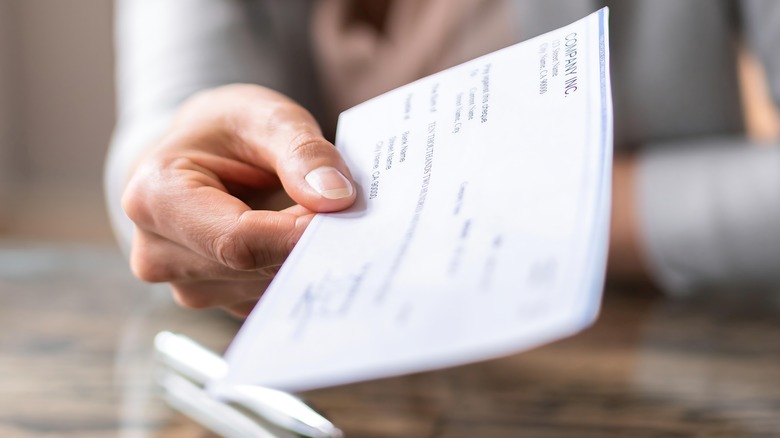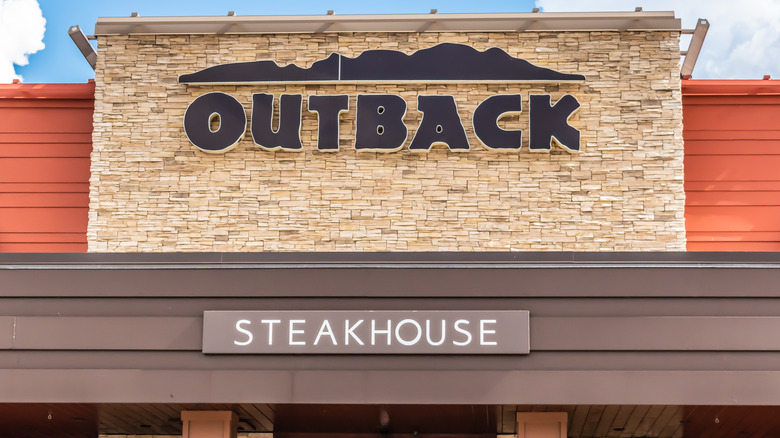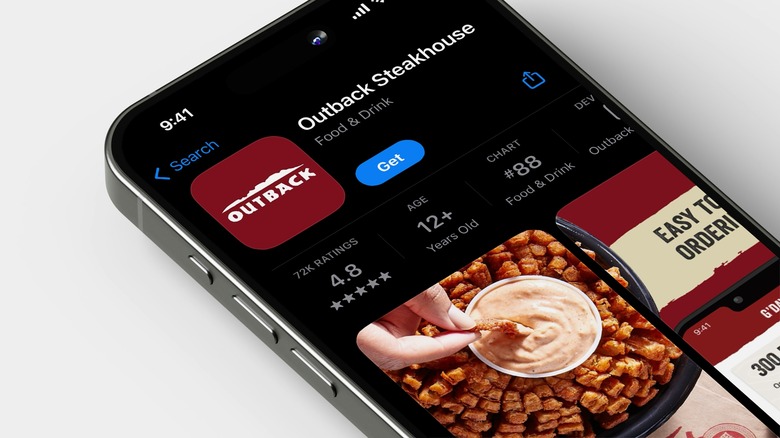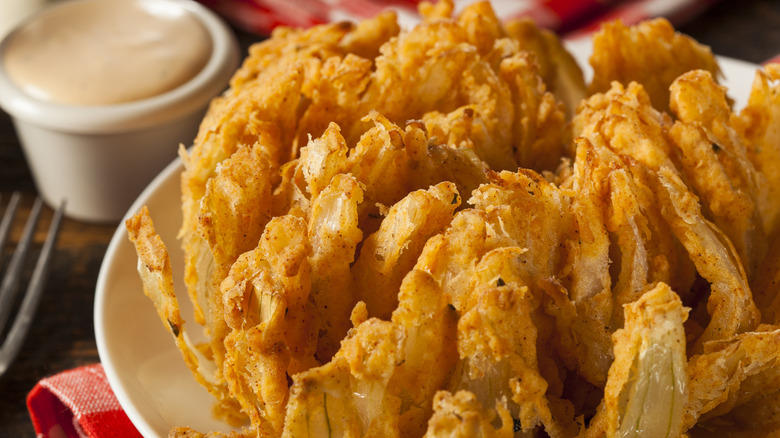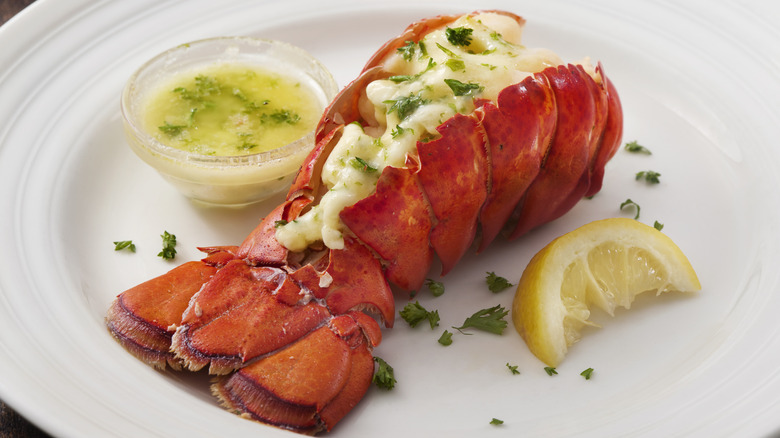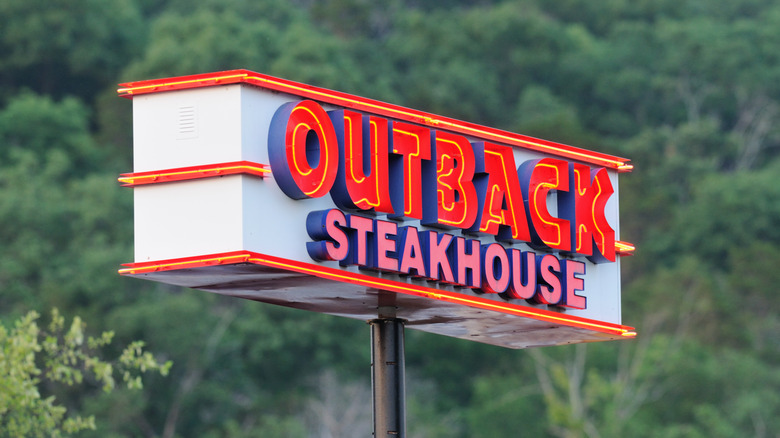12 Reasons Outback Is Cheaper Than Other Steakhouses
If you grew up in the U.S., then chances are good that you have at least a few fond memories of Outback Steakhouse. This restaurant chain has been around since 1988, providing a wide variety of Australian-inspired dishes in a casual setting. It's the perfect place to go when you don't want fast food but don't want to get dressed up for a fancy establishment, either. So, it's no wonder why American families dine out at Outback so much.
Another reason for the restaurant's popularity is that despite being around for decades, its menu still has jaw-droppingly low prices. As of this writing, some locations offer the tasty Bloomin' Onion for as low as $12.59, and an entire center-cut sirloin steak is available for just over $20. This has enabled families to keep dining out, but how has Outback been able to continuously entice customers with low prices, even as the years pass and inflation increases? Here are 12 reasons why the chain is cheaper than other steakhouses.
1. Instead of Prime, Outback uses cheaper Choice beef
Outback Steakhouse claims to use the highest quality Choice beef. It's fresh from the Midwest, and the cows are grain-fed, which is why the steaks are so darn good. So, how are the prices so low, especially compared to those of other steakhouses?
The key words here are "Choice beef." To understand what "Choice" means, let's first look at Prime, which the USDA considers the highest grade of beef. This meat comes from young cattle, and there's plenty of marbling, which makes the steaks moist and tender. Typically, higher-end restaurants will use Prime beef for their steaks, which is why the price tags are so high.
Outback, on the other hand, uses Choice beef. It's still relatively high-quality, but it has less marbling, making it a medium-tiered cut. You'll still get a mouthwatering steak, just at a much lower cost. This is why the 6-ounce center-cut sirloin is one of the cheapest items at Outback Steakhouse. On the bottom is Select beef, which has the least marbling. (If you're curious, most supermarkets sell Choice and Select cuts.)
3. Outback lowers prices when new menu items are introduced
To keep guests interested in its offerings, Outback Steakhouse constantly rethinks its menu. And we don't just mean the items themselves, either — the chain also reorganizes categories so you can find your favorite dishes (and some new ones) more easily. For example, back in September 2020, Outback organized its steaks by cooking style so you wouldn't have to deliberate anymore.
More importantly, whenever the restaurant makes menu changes, it also lowers prices and gives you more value for your money. With the late-2020 menu change, Outback added a free second side to many of its steak orders. It even lowered the price of its Bloomin' Onion by $1 to help customers save. The chain further enticed diners by making steak upgrades cost as little as $2, which, admit it, makes it irresistible to treat yourself to a bigger hunk of meat.
5. Outback maintains low costs by ordering onions in bulk
Outback Steakhouse is famous for its Bloomin' Onion appetizer. Few diners can resist ordering one of these deep-fried delights to split with their table. It's so delicious that you may find yourself craving it at home, and you can definitely recreate this dish in your kitchen — just make sure to use our soaking tip for making your Bloomin' Onion restaurant-worthy.
Every year, customers order over 8 million Bloomin' Onions, and according to Outback, this item makes up around 25% of all appetizers ordered. Given how popular the Bloomin' Onion is, many may be surprised to see how affordable it has remained over the years. As we've mentioned, Outback sometimes even lowers this price.
The secret is that the chain orders its colossal onions in bulk. It uses over 14 million pounds of these giant onions every year, and the restaurant works with around 15 growers located throughout Idaho, Oregon, Texas, and California. This ensures that Outback can affordably secure enough colossal onions to feed its hungry guests.
6. Low wages at Outback help maintain low prices
Unfortunately, chain restaurants have a reputation for paying their employees low wages, and Outback Steakhouse is no exception. At the time of this writing, data from Indeed indicates that on average, Outback's line cooks get paid $16.71 per hour, whereas hosts and hostesses get paid $15.03 per hour. Servers are paid slightly more at $18.61 per hour, but this still isn't a very high wage in most parts of the country. Glassdoor also shares similar numbers, with line cooks earning between $33-39,000 per year and hosts earning $25-35,000 per year.
To make matters worse, some Outback locations have been accused of underpaying their staff. In particular, the Penrith, Australia location was accused of underpaying its junior staff back in 2022. Not only were they paid less than the government-mandated minimum wage, but they didn't receive pay slips or even copies of their work contracts. Hopefully, this isn't the case at every location and most staff are being paid acceptable wages.
7. Outback is making great profits from off-premise sales
As our lives get busier and busier, we rely more on ordering takeout or picking up food to take home. What's more, the pandemic forced establishments to (temporarily) close up their restaurants, which forced them to turn away in-person customers and focus on off-premise sales instead. This is evident when you see that, according to data shared by CNN, 29% of Outback Steakhouse's revenue in Q4 2021 was from takeout and deliveries. This is almost double the reported number for Q4 of 2019, and it's unlikely to return to pre-pandemic levels anytime soon. Most of us have realized that ordering delivery saves both time and money, and restaurants are shifting their business tactics to accommodate this.
By focusing on off-premise sales, Outback is able to reduce its overall costs. Because the chain is able to pass some of these savings on to the customers, the result is extremely competitive dine-in prices. Also, by pricing on-premise menu items low, Outback makes dining in more appealing, which may convince some customers to drop in more often.
8. The restaurants are getting smaller
As a result of the pandemic, there's been an undeniable spotlight on delivery and takeout orders for pretty much all restaurants. As such, it makes sense that Outback wants to keep boosting these sales — this enables the chain to leave dine-in prices relatively unchanged. To accommodate these off-premise demands, Outback Steakhouse is reducing restaurant sizes by 17%, making them around 5,000 square feet in size (via CNN). With smaller spaces to look after, the restaurant will have fewer expenses, as factors like utility costs will decrease. In addition, this makes expansion easier since Outback doesn't have to pay as much for real estate. With more expansion comes lower prices.
Not only are Outback restaurants getting smaller, but their layouts are, too. According to CNN, "New locations have a dedicated space for pickup orders." The chain's bars also have 30% less seating, and a number of four-top tables have been switched out for two-tops. By adapting to customer demands, Outback is able to beat its competition's prices.
9. It's boosting customer loyalty with its app
Attracting new customers requires tremendous effort compared to retaining an existing client base. In fact, acquisition can cost anywhere from five to 25 times more than retention. Therefore, a smart way for businesses to keep costs down is to concentrate on customer loyalty, and that's exactly what Outback Steakhouse has done with its smartphone app.
The app's main objective is to provide a smooth experience. Not only can diners view wait times and put themselves on the waitlist, but they can also check their progress as time goes on. Once inside the restaurant, customers can view and pay their bill to decrease wait times even further.
More importantly, the Outback Dine Rewards Program contains exclusive offers and discounts. All of these factors encourage diners to choose Outback Steakhouse for their meals out, which puts less pressure on the chain to acquire new customers.
10. It uses a special onion cutter to increase efficiency
As previously mentioned, Outback Steakhouse sells over 8 million Bloomin' Onions per year. It already keeps prices low by ordering its colossal onions in bulk, but these bulbs don't come pre-cut, and the workers also have to dredge them. As you can imagine, slicing these onions, preparing the batter, and deep-frying them is no easy feat; it's a labor-intensive process, so how can customers still order these apps for under $15?
Outback's secret weapon is an ingenious device: the Gloria onion cutter. For a few years after Outback introduced the Bloomin' Onion in 1988, the chain's poor employees had to cut each onion by hand. But the onion cutter changed everything. Now, all employees have to do is place the peeled onion and push down on the device. Not only does the Gloria cutter immediately slice the onion into multiple pieces, but it also cores the middle. The employee can then pick it up with tongs to dip it in the batter, and into the deep fryer it goes. This efficient process means more Bloomin' Onions can be churned out in a given amount of time.
11. Its iconic steamed lobster tails might be microwaved
Outback Steakhouse's lobster tails are oh-so-delicious, and the price tag isn't too bad, either. As a result, customers feel more comfortable getting either the surf-and-turf option or the two lobster tails for an extra-special treat. Most people know lobsters as a classy food, one that must be cooked to perfection by a skilled chef who then carefully drizzles hot garlic butter all over the meal before sending it out to customers. But sadly, this may not be the case at Outback. TikTok user @dirtdawg420, seemingly an Outback employee, revealed in a video how they prepare the lobster tails, and it's a disappointment.
As you may have guessed, they simply nuke them in the microwave. Considering that anyone can place lobster tails in a container with water and dial in numbers on a microwave, there's certainly no master chef prepping this dish. This may be how Outback serves such affordable lobster tails — regular restaurant employees can prep this menu item with no need for experience or advanced skill. But the key to the best poached lobster tail is to cook them off the heat, so take a page from us if you want an elevated taste at home.
12. Outback is investing in technology to keep prices low
Outback Steakhouse doesn't shy away from changing times. The chain is constantly looking for ways to improve service, and one way to do so is to say goodbye to old methods and hello to new ones, usually with the assistance of new tech. It's not all bells and whistles, either, as Outback makes easy adoptions that still result in a huge difference.
For one, servers now have handheld tablets instead of pens and paper. This allows them to take down numerous orders with a smaller margin of error, which results in less food waste. Plus, they can send these orders to the kitchen immediately, which significantly boosts efficiency. Outback has also invested in completely new kitchen equipment to accommodate both on- and off-premise orders. One such instrumental piece of equipment is the clamshell grill, which cooks steaks 50% faster. Better efficiency means happier customers, and this means repeat business and lower prices.
